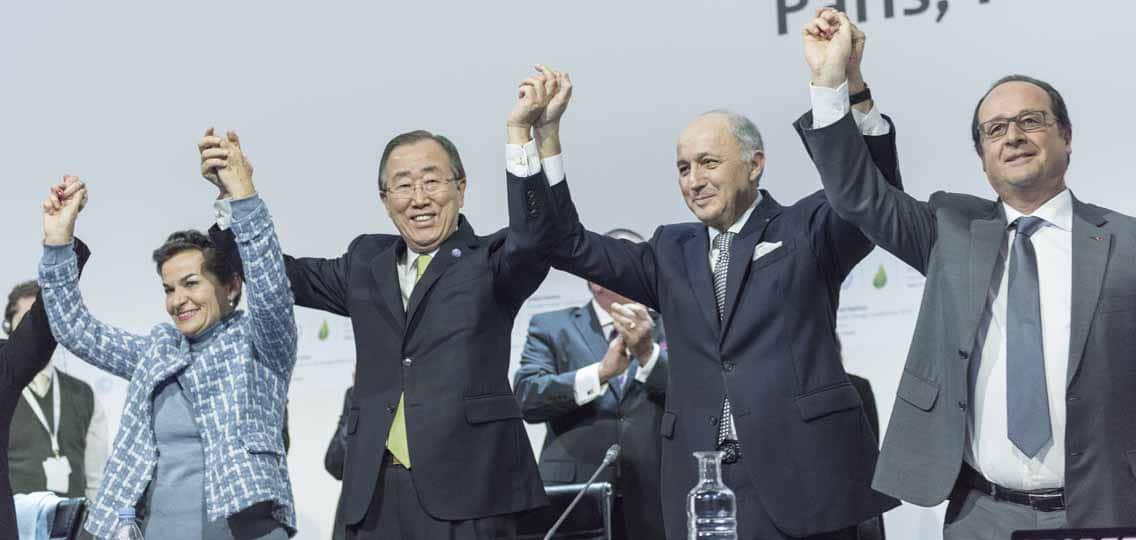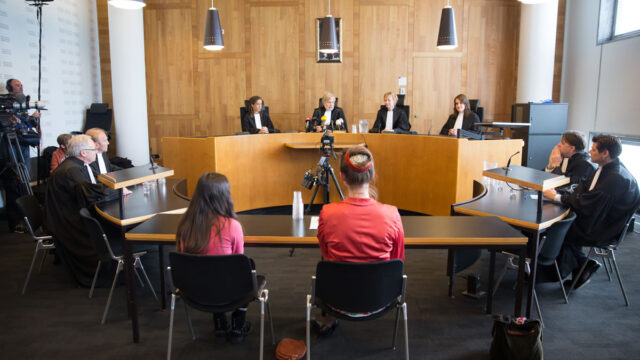Taking a look at the legal powers in the Paris Climate Agreement and what it could mean for our climate future
The 2015 United Nations Climate Change Conference (COP21) sparked important discussions this past December — including the importance of fossil fuel divestment, the world warming limits, and climate finance. And, in the final days of the conference, the world witnessed an act of global solidarity after 195 nations signed the Paris Climate Agreement. The source of much controversy, the Agreement was not only said to be a historic landmark but also an ambitious one for climate action.
With world leaders back at home, and the new year just beginning, Ecojustice lawyer, Scott McAnsh takes an in-depth look at the Agreement’s legal powers, and what it could mean for climate action in the coming years.
International agreements come in many different forms. They range from purely aspirational to legally binding with punitive consequences for non-compliance. The Paris Agreement, adopted in December at the close of the 21st Conference of the Parties to the United Nations Framework Convention on Climate Change (UNFCCC), falls squarely somewhere in between.
Over the next few months, countries will begin to work through the implications of the Paris Agreement. We see the Agreement as a strong political gain in the global fight against climate change. However, the legal text is largely aspirational and procedural and is not a bold legal response to the climate change crisis.
The goals of the Paris Agreement are laudable and highly ambitious, with a statement that an increase of no more than 1.5 degrees Celsius above pre-industrial levels is desired. Agreement on that target is important, and one of the biggest victories for the climate in Paris. The mechanism for getting there is a platform for peer pressure, not enforcement, sanctions or other measures with meaningful consequences for the parties, such as exist in the world of international trade.
The legal obligations found in the Paris Agreement primarily deal with reporting to the international community. Parties are required to share their nationally determined contributions (4(3)) every 5 years (4(9)) for inclusion in a public registry (4(12)). Developed countries are required to financially support developing countries to help them meet their obligations (9(1)) and report on that support every two years (9(5)). Parties also have to regularly report their greenhouse gas emissions and carbon sink capacity (13(7)). That is pretty well the extent of the binding obligations on the Parties to the Paris Agreement.
The Paris Agreement is a significant change for global climate efforts, which were governed by the Kyoto Protocol that was negotiated in 1997. The much maligned agreement required developed countries to meet set emissions reduction targets, which would increase over time. The Kyoto Protocol was largely modeled on the highly successful Montreal Protocol — the primary tool for phasing out ozone depleting substances. That Protocol set specific limits on the production and consumption for each substance which decreased over time until a set date at which they would reach zero.
Unfortunately what was lacking from both the Montreal Protocol and the Kyoto Protocol was sanctions for non-compliance — there were no clear consequences for countries that refused to comply with costly greenhouse gas reduction strategies. As a result, the Kyoto Protocol failed to have buy in from many countries, such as the United States, and saw open non-compliance in signatories like Canada, who ultimately withdrew from the Kyoto Protocol in 2011.
The General Agreement on Tariffs and Trade, 1994, has mechanisms by which states can face consequences for non-compliance. Recently, Canada was given approval to impose over a billion dollars a year in tariff restrictions on the United States for its failure to comply with the country of origin labelling rules in the agreement. To date, there has been no appetite for those kinds of powers in a climate agreement. The Paris Agreement is explicit that its transparency framework should be implemented in a non-punitive manner (13(5)).
That is likely a reflection of the political landscape of climate change as opposed to trade. The Paris Agreement is a new approach to the problem of climate change after the command and control structure of the Kyoto Protocol failed. The Paris Agreement works on peer pressure. Naming and shaming has had some success in the human rights area, and might have the same effect in climate change.
The mandatory provisions in the Paris Agreement are publicly available commitments and progress reports. The framework of the Paris Agreement is that everyone can see what you said you would do to reach a shared aspirational goal and what you did to get us there. This approach only works if failing to make big commitments and meet them has political consequences. The Paris Agreement has the potential to change the discourse and move us forward if the pressure to take action remains.
While we are hopeful that the new political landscape apparent in the negotiation of the Paris Agreement will lead to strong action on climate change, there may come a time when an agreement with sanctions will be needed. Climate change will have staggering economic impacts, a reality acknowledged by leading financial institutions. As those impacts are realized, the international pressure to see that everyone takes meaningful action will increase. We hope that naming and shaming on the international stage will work, but expect that someday sanctions will follow.
The Paris Agreement cannot work on its own to fix climate change, it needs all the nations signed on to fulfill their commitments for positive action to happen in the coming years. Canada’s provinces need to work together to produce, and implement a credible plan — one that says no to pipelines and other major projects that come with unacceptable climate impacts, and makes sure that polluters pay when they dump carbon into the air we all breathe.
The Paris Agreement provided an understanding of what needs to be done, and now it is up to everyone, including Canada, to make sure that the obligations set-out are fulfilled. The Agreement has us moving in the right direction, let’s make sure we don’t lose that momentum.


